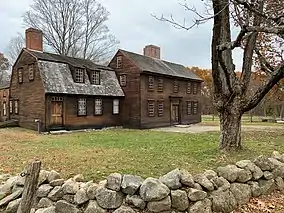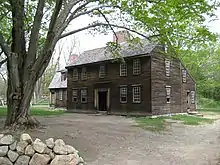Hartwell Tavern
Hartwell Tavern is a historic American Revolutionary War site associated with the revolution's first battle, the 1775 Battle of Lexington and Concord. It is located on Battle Road (formerly the Bay Road) in Lincoln, Massachusetts, and operated as an historic house museum by the National Park Service as part of the Minute Man National Historical Park. It is staffed from Memorial Day (May) weekend to October by park rangers dressed in colonial attire who offer programs daily.
| Hartwell Tavern | |
|---|---|
 Hartwell Tavern, Lincoln, Massachusetts | |

| |
| General information | |
| Architectural style | Saltbox |
| Location | Lincoln, Massachusetts (Concord until 1754) |
| Address | Battle Road |
| Coordinates | 42.4538°N 71.2932°W |
| Construction started | 1732 |
| Completed | 1733[1] |
| Technical details | |
| Floor count | 3 (including the cellar) |
History
The building, whose main façade faces south, was originally constructed as a home for Ephraim Hartwell (1707–1793) and his newlywed wife, Elizabeth (1714–1808), in 1733. It was given to them by Ephraim's father, Samuel (1666–1744), who lived in a home with his wife, Mary, about 700 feet east along Battle Road. Built in the 1690s, only the central chimney of Samuel and Mary's house still stands, amongst a basic reconstruction of the building.[2] The gifted home stood on 18 acres of land.[1]

The Hartwells raised a family and, in 1756, when they had nine children living in the house, Ephraim applied for a license to run the home as an inn. It was run as such until the 1780s.[1]
When Samuel died in 1744, aged 78,[3] Ephraim inherited his portion of the family farm. By 1749 the farm was one of the most productive in Concord and consisted of 141 acres.[4]
The property was part of Concord until 1754, when the town of Lincoln was incorporated.[4]
Ephraim died in 1793, aged 86.[5] Elizabeth survived her husband by fifteen years; she died in 1808, aged 94.[6]
The house continued to be a residence up until its purchase by the National Park Service in 1967. Over the years that followed, the building was modernized and changed.[1]
In the 1980s, the Park Service restored it to its 1775 appearance, yet kept its 1783 and 1830 additions. The main structure, the foundation, most of the walls and some of the flooring are 1733 originals. It is estimated that about 65% of the original structure remains within the restored building.[1]
Battles of Lexington and Concord
The Battle of Lexington and Concord took form before dawn on April 19, 1775. Soldiers passed by the tavern on their way to Concord, and again on their way back to Boston. Three of the Hartwells' children — Samuel, John and Isaac — were in the Lincoln minutemen that fought at Old North Bridge and on the battle road. All three later served in the Revolutionary War.[1]
Paul Revere and William Dawes were detained by a British Army patrol nearby during the "Midnight Ride" to Concord of April 18. Samuel Prescott, who was also riding with them, escaped by jumping his horse over a wall and into the woods. Prescott emerged at the Hartwell Tavern, awakened Ephraim and informed him of the pending arrival of the British soldiers. Ephraim sent his black slave, Violet, down the road to alert his parents. Mary then relayed the message to Captain William Smith, commanding officer of the Lincoln minutemen, who lived a little to the west and whose home still stands along Battle Road. The minutemen received the notice in time, and arrived at Old North Bridge before their enemy.[1] Prescott made it to Concord.[7]
References
- The Historic Hartwell Tavern - NPS.gov
- Samuel Hartwell House site - NPS.gov
- Samuel Hartwell (1666−1744) at FindAGrave.com
- "The Hartwell Tavern and the Hartwell Family in Closer Detail" - NPSHistory.com
- Ephraim Hartwell (1707–1793) at FindAGrave.com
- Elizabeth Hartwell (1714–1808) at FindAGrave.com
- Fischer 1994, pp. 131–132, 144.